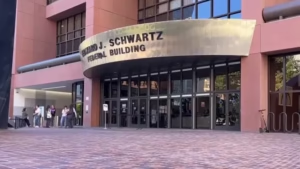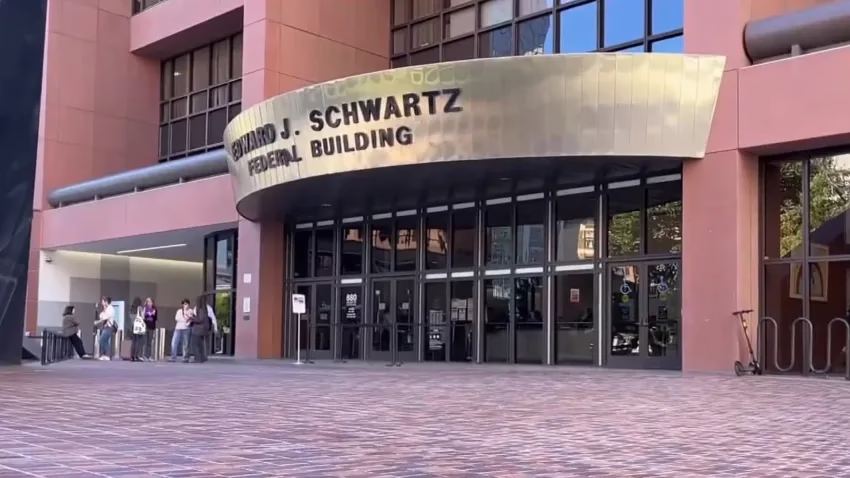U.S. Immigration and Customs Enforcement has detained hundreds of migrants in the basement of San Diego’s federal courthouse, turning the space into a makeshift holding site amid a shortage of space in official detention centers.
An investigation by several media outlets has revealed that U.S. Immigration and Customs Enforcement (ICE) is currently holding around 200 migrants in the basement of the federal courthouse in downtown San Diego due to a lack of space in official detention centers.
These arrests are part of a new enforcement practice in which routine administrative appointments, known as “check-ins,” are being used as pretexts for immediate detention. The strategy comes amid pressure from the White House to increase daily arrests.
While ICE has maintained that all its operations comply with federal standards, the agency has yet to officially comment on the reports regarding the conditions and legality of the courthouse detentions. Efforts to obtain a response from government officials on these allegations have also not yielded any detailed answers, reflecting ongoing concerns about transparency and accountability.
Border Report noted that hundreds across the United States, from Los Angeles to New York, have been detained after appearing for routine ICE appointments. Attorneys confirmed that clients, many longtime U.S. residents, were summoned for administrative matters and then taken into custody and placed in makeshift holding areas beneath the San Diego courthouse.
These improvised detentions result from overcrowding at Otay Mesa Detention Center, leaving ICE to use courthouse basement rooms without medical facilities or independent oversight. Families cannot locate detainees in ICE’s database and remain without information on their health or status. However, families and advocates may contact immigration attorneys or local advocacy groups in the area, which may provide guidance or assist with tracking detainees. They can also reach out to organizations specializing in immigrant rights to seek advice on how to report concerns or to check on the well-being of the detainees.
An attorney, voice trembling with emotion, described the conditions as “inhumane,” pointing to unbearably cold temperatures, the humiliation of no privacy in the restrooms, and food described as “not fit to eat.” Other lawyers spoke with visible frustration about detainees being denied medical care—some suffering visibly from untreated chronic pain. One legal representative recounted how his clients are forced to sleep directly on the hard floor, shivering under thin blankets, trapped for days in windowless rooms cut off from the outside world.
The situation has sparked a political outcry in San Diego.
On October 20, Democratic Representatives Juan Vargas and Scott Peters, who represent the county, held a press conference outside the courthouse to condemn the detentions. “We have received reports indicating that several individuals are being held in the basement of this building well beyond legal and human limits,” Vargas said, adding that federal officials have refused to disclose the exact number of detainees or their identities. “Normally, you can ask how many people are being detained, their ages, and whether families are involved. This time, we have been told nothing,” he insisted. In response to the situation, Vargas and Peters have urged the Department of Homeland Security to commence an immediate investigation into the courthouse detentions and have called for legislative measures that require ICE to provide transparent reporting of all detention operations. Additionally, they intend to propose a resolution demanding better oversight of ICE facilities and operations, ensuring that congressional members are informed about the number and conditions of detainees.
These proposals aim to prevent further violations and ensure accountability.
According to NBC San Diego, this surge in arrests began in early October 2025 when volunteer observers recorded 11 detentions during routine check-ins. Within four days, that number had risen to 44 and has since climbed into the hundreds by late October, according to estimates from attorneys and local advocacy groups.
These mass detentions appear to be linked to a political directive from the White House and Stephen Miller, Deputy Chief of Staff to President Donald Trump, who has reportedly pushed ICE to reach a quota of at least 3,000 arrests per day nationwide.
For several weeks, internal sources have reported that agents are being encouraged to “optimize” operations by conducting arrests during scheduled visits — considered “low-risk” targets since they involve individuals already known to the agency.
Several cases lay bare the human toll of these actions. Among those detained in San Diego are the heartbroken parents of a U.S. service member, taken into custody while visiting their daughter at Camp Pendleton. The couple, initially released with ankle monitors, suffered the trauma of being detained again just days later when they dutifully appeared for an ICE appointment. Their attorney, voice filled with anger, called the arrests a “flagrant violation of trust between families and the state,” underscoring the pain of a family betrayed after voluntarily complying with the law.
The Latin Times noted that the situation in San Diego reflects a nationwide pattern.
In cities like New York, Chicago, and Atlanta, several NGOs have reported that immigrants under regular administrative supervision are now being detained upon arrival at ICE offices. Human rights advocates have condemned what they call an “administrative trap” policy, arguing that it violates federal due process protections guaranteeing individuals a fair procedure before any deprivation of liberty.
Local officials are now calling on the Department of Homeland Security (DHS) to immediately end these improvised detentions and provide transparency regarding conditions in unlisted holding facilities.
For now, ICE has not disclosed the number of people being held under the courthouse or the length of their detention. The agency has only issued a brief statement asserting that “all detention operations comply with federal standards and available resources.”







